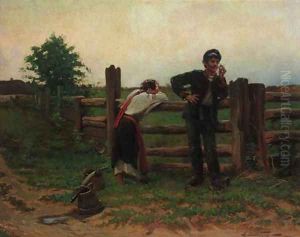Aleksandr Vladimirovich Makovskii Paintings
Aleksandr Vladimirovich Makovsky was a Russian painter and graphic artist born on August 6, 1869, in Moscow. He was part of the prominent Makovsky family of artists, which included his father, Vladimir Makovsky, who was a co-founder of the Peredvizhniki (Wanderers) movement, and his uncle, Konstantin Makovsky, who was also a well-known painter. Aleksandr Makovsky's artistic lineage provided him with a robust environment for nurturing his talent from an early age.
Makovsky's early work was influenced by his father's social consciousness and the realistic style of the Wanderers. However, he also developed an interest in the more academic and classical approaches to art, as seen in the works of his uncle Konstantin. Aleksandr enrolled in the Moscow School of Painting, Sculpture, and Architecture, where he honed his skills and developed his own artistic voice. His education continued at the Imperial Academy of Arts in Saint Petersburg, where he further embraced academic traditions.
Upon completing his education, Makovsky participated in various exhibitions and became a member of the Moscow Society of Lovers of the Arts. He was recognized for his portraits and genre scenes, which often encapsulated the everyday lives and customs of the Russian people, as well as historical and theatrical subjects. His works were characterized by a keen observation of detail, a vibrant palette, and a dynamic composition, blending the academic style with elements of Impressionism and Realism.
During his career, Makovsky also engaged in teaching and worked as a graphic artist, contributing illustrations to various publications. His legacy is somewhat overshadowed by the more famous members of his family, but his contribution to the Russian art scene at the turn of the century was significant.
Aleksandr Vladimirovich Makovsky's life came to an end on March 23, 1924, in Moscow. Although not as widely recognized internationally as some of his contemporaries, his work remains appreciated by connoisseurs of Russian art and is represented in several Russian museums, continuing to provide insight into the cultural and social fabric of his time.
